Ontocetus emmonsi
Quick Facts
Common Name: Emmon’s walrus
Ontocetus emmonsi is an extinct species of walrus which inhabited the North Atlantic during the Pliocene.
Fossils of Emmon’s walrus can be found in Florida, up the Eastern Atlantic coast, in Europe, and North Africa. This pattern is attributed to migration along the North Atlantic Gyre, an ocean current that circulates clockwise in the North Atlantic.
Like the modern walrus, Ontocetus emmonsi had large tusks. These tusks are the most commonly found type of fossil for this species.
Age Range
- Early Pliocene Epoch; late Hemphillian and early Blancan land mammal ages
- About 5 to 3 million years ago
Scientific Name and Classification
Ontocetus emmonsi Leidy, 1859
Source of Species Name: The species name, emmonsi, honors Professor Ebenezer Emmons. He was the State Geologist of North Carolina between 1851 and 1863 and collected the holotype specimen (Kohno and Ray, 2008).
Classification: Mammalia, Eutheria, Laurasiatheria, Carnivora, Caniformia, Arctoidea, Pinnipedia, Odobenidae, Odobeninae
Alternate Scientific Names: Trichecodon huxleyi, Alachtherium crestsii, Hoplocetus emmonsi, Prorosmarus alleni, Odobenus huxleyi, Odobenus antverpiensis, Alachtherium africanum, Ontocetus emmonsii
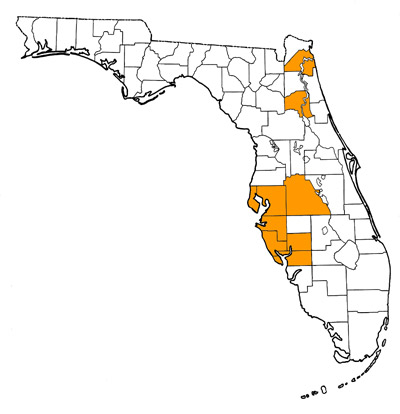
Overall Geographic Range
In addition to fossil occurrences in Florida, Ontocetus emmonsi fossils have been found along the eastern coast of the United States in Georgia, South Carolina, North Carolina and Virginia, as well as Europe and Morocco (Kohno and Ray, 2008). The type locality is near the town of Murfreesboro in Hertford County, North Carolina.
Florida Fossil Occurrences
Florida fossil sites with Ontocetus emmonsi:
- Charlotte County—Punta Gorda Area
- De Soto County—Peace River 3B
- Duval County—Fulton Cutoff; St. John’s River Dredge
- Hillsborough County—Leisey Shell Pit 1C; Leisey Shell Pit 3
- Manatee County—Bradenton Area
- Pinellas County—Burton’s Oyster Shell Yard
- Polk County—Payne Creek Mine, Agrico; Silver City Mine, Swift/Estech; Fort Green Mine, Agrico; Whidden Creek Site, Fort Meade Mine, Gardinier Inc.
- Putnam County—Devil’s Elbow 2
- Sarasota County—Bass Point Waterway (West Side); De Soto Lakes; Macasphalt Shell Pit 1, Richardson Road Shell Pit locality 6A; Quality Aggregates locality 7A; Quality Aggregates Pit 8 & locality 8A; SMR Aggregates Pit 10; Venice Area
Discussion
Ontocetus emmonsi is an extinct species of walrus which inhabited the North Atlantic during the Pliocene. Ontocetus emmonsi is the type species and only species in the genus Ontocetus. It is placed within the family Odobenidae which includes only one living species, the walrus Odobenus rosmarus (Demere, 1994). Like Odobenus, Ontocetus is included in the subfamily Odobeninae, or “tusked walruses” and is characterized by large, continuously growing tusks, or modified canine teeth (Kohno and Ray, 2008). Despite strong support for relationships within Odobenidae, it is currently unknown as to whether this family is more closely related to Phocids (true seals), or Otariids (eared seals) (Berta and Churchill, 2012). Initially thought to be a cetacean (Leidy, 1859), the genus name Ontocetus comes from the Greek ontos, meaning being, and ketos, meaning whale or large sea animal (Kohno and Ray, 2008).
Historically, many authors have attributed Pliocene walruses from the Atlantic to numerous different genera, largely based on isolated and fragmentary tusk fossils (see Kohno and Ray, 2008 for a full discussion). Florida specimens were typically referred to Trichecodon huxleyi (e.g., Ray, 1960). Recent consideration of individual and ontogenetic variation, as well as sexual dimorphism and size disparities among different age groups has led to the synonymy of all Atlantic Pliocene walruses into a single genus, Ontocetus (Kohno and Ray, 2008). These authors noted that much of the variation between different taxa could be observed within one population of Ontocetus emmonsi from the Lee Creek Mine in eastern North Carolina. Furthermore, many of the characters used to establish these new taxa could also be found in the holotype specimen of Ontocetus emmonsi (Leidy, 1859; Kohno and Ray, 2008).
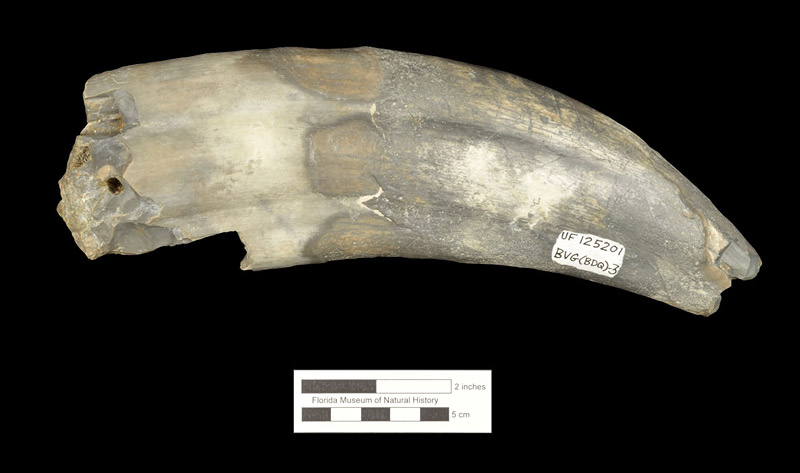
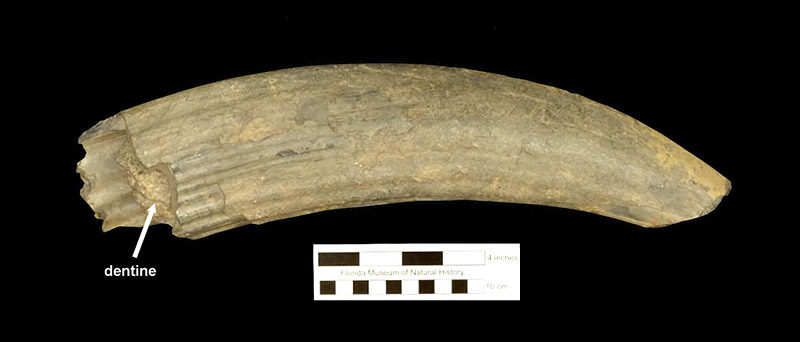
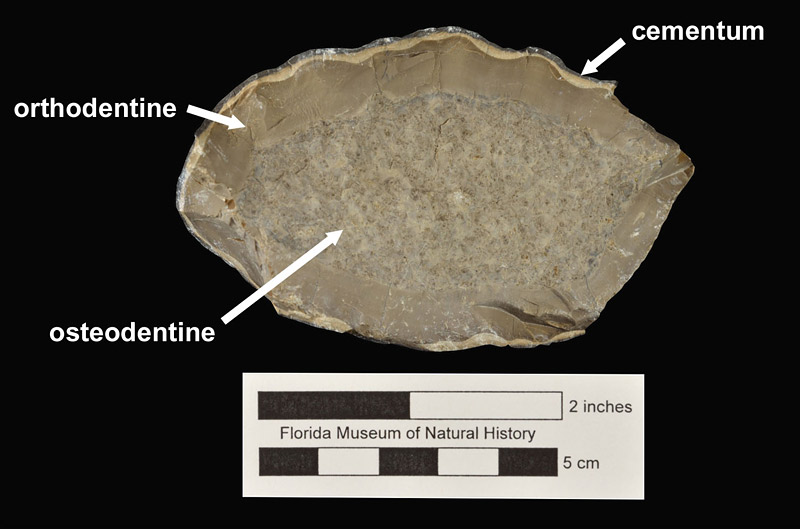
Tusk fossils are by far the most common Ontocetus fossils to find, particularly in Florida (Figs. 2-3; Ray, 1960; Hulbert and Ray, 2001). Partial tusks can be identified against other common Florida fossils with the same general shape and size, such as dugong ribs and large sperm whale teeth, by their characteristic osteodentine core, which has a globular texture. Surrounding this core is a layer of smooth orthodentine, and the outermost part of the tusk is composed of a very thin layer of cementum (Fig. 4; Kohno and Ray, 2008). Tusks of Ontocetus emmonsi differ from other Odobenine genera in having a stronger posterior curvature and taper, exhibiting fluting (grooves) along their length, and being more compressed laterally (Kohno and Ray, 2008).
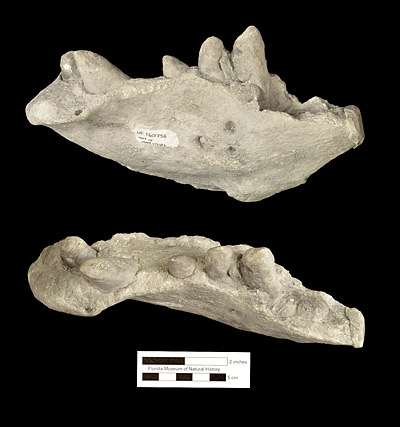
The paleoecology of Ontocetus emmonsi is inferred to be similar to that of Odobenus rosmarus, although it inhabited far warmer waters. However, stronger sexual dimorphism in Ontocetus emmonsi suggests that this species may have exhibited stronger polygynous breeding behavior, more comparable to that of otariid seals (Kohno and Ray, 2008). Additionally, size differences between tusk fossils found in Florida and further north along the Atlantic coast show that Florida fossils tend to be larger overall, and most likely represent mature male walruses. The tusks from the Carolinas and Virginia tend to be smaller and are typically referred to females and juveniles. This trend is interpreted to be the result of differential migration patterns among males and females, with the timing of seasonal migration being offset for each (Kohno and Ray, 2008).
The paleobiogeography of Ontocetus emmonsi was strongly influenced by the changing ocean configuration during the Pliocene. Ontocetus emmonsi is thought to have originated in the Northern Pacific Ocean and then dispersed into the Atlantic via the Central American Seaway between North and South America in the early Pliocene (Kohno and Ray, 2008). Later dispersal via the North Atlantic Gyre, a circulating ocean current moving in a clockwise fashion between North America and Europe, led to their eventual appearance in Europe and North Africa (Kohno and Ray, 2008; Naafs et al., 2010). This dispersal pattern would account for the later appearance of Ontocetus emmonsi fossils in European localities relative to those of North America.
Ontocetus emmonsi became extinct before the beginning of the Pleistocene, and more importantly, before the first appearance of Odobenus rosmarus in the Atlantic. It is therefore unlikely that competition led to its eventual extinction. Instead, environmental changes such as changing ocean temperature are thought to be the cause (Kohno and Ray, 2008).
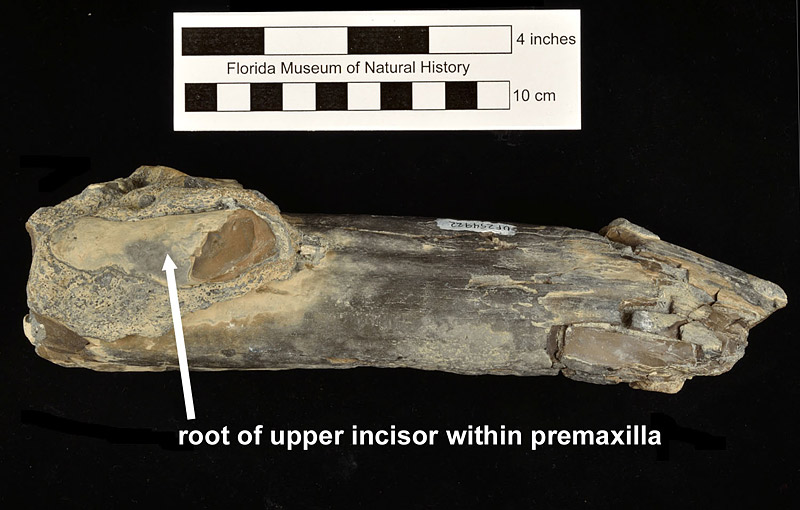
The greatest number of specimens found in Florida derive from commercial shell pits on either side of Interstate Highway 75 near Sarasota; Macasphalt Shell Pit on the west side; Richardson Road (later Quality Aggregates, and then SMR Aggregates) Shell Pit on the east side (Figs. 4, 6). Fossils of Ontocetus emmonsi from these quarries come from beds 10 and 11, which are Pliocene in age. All walrus fossils from Florida are regarded as belonging to this species.
Sources
- Original Author(s): Sarah Widlansky
- Original Completion Date: November 30, 2012
- Editor(s) Name(s): Richard C. Hulbert Jr.
- Last Updated On: March 3, 2015
This material is based upon work supported by the National Science Foundation under Grant Number CSBR 1203222, Jonathan Bloch, Principal Investigator. Any opinions, findings, and conclusions or recommendations expressed in this material are those of the author(s) and do not necessarily reflect the views of the National Science Foundation.
Copyright © Florida Museum of Natural History, University of Florida